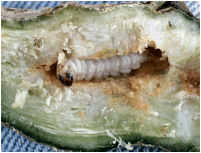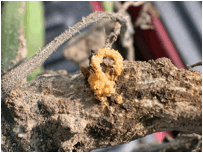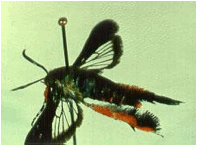Squash Vine Borer
The squash vine borer (Melittia cucurbitae) (SVB) can be a devastating pest of plants in the cucurbit family which includes melons, squashes, pumpkins and cucumbers. In seasons with high populations, entire home garden crops of susceptible hosts may be lost. Losses are usually most severe in gardens or fields where losses were experienced the previous season.
Host Plants
All cucurbits can be attacked by the squash vine borer but the most susceptible are squash and pumpkins. Cucumbers and melons are less susceptible.
Damage
Most plant damage results from larvae tunneling and feeding within the stems or vines (Figure 1). The first noticeable symptom is usually wilting that disappears at night when transpiration slows. As damage progresses, vines will no longer recover, will not respond to watering and may die. Look for tiny larval entry holes near the base of the affected vine to confirm the presence of SVB. Orange to greenish tan frass (waste) that looks like sawdust may be present near the hole (Figure 2).

Figure 1. Larva of the squash vine borer. Photo: R. Durgy

Figure 2. SVB frass at the base of an infested vine. Photo: J. Boucher
Description and Life Cycle
The adult squash vine borer is a clear-winged moth (Figure 3) that resembles a wasp. Unlike many moths, it is active during the day. The abdomen is orange with black spots (Figure 4). Adult emergence from the soil coincides with the early growth stages of the plant, usually in mid to late June. Egg laying begins soon after and lasts for 5 days until the adult female dies. The tiny, flattened, dull red to brown eggs are laid singly near the base of the vine or leaf stalk. Hatch occurs in 7 to 10 days and the young larvae burrow immediately into the stem and begin feeding. Feeding continues for 4-6 weeks in the middle of the stem towards the growing tip. In a severe infestation or when a vine is depleted, larvae may feed on developing fruit as well. At maturity the larvae leave the stem and burrow into the soil near the plant where they will overwinter as pupae. In the northeast, there is one generation per year. In the south, the SVB may have two generations per year.

Figure 3. Adult SVG showing clear wings and orange hind legs. Photo: Univ. of MN.

Figure 4. Adults mating. Note orange abdomen with black spots. Photo: Univ. of MN extension.
Management
The most effective approach to reducing damage by the SVB is use IPM or Integrated Pest Management. This combination of multiple preventive and post-infestation practices will reduce plant damage and reduce the need for chemical insecticides.
Preventive measures:
Include growing resistant cucurbits, floating row cover, crop rotation, sanitation, stem barriers, adult traps, late planting, rooting at nodes, and insecticides.
- If you’ve had trouble with the SVB in the previous season, grow only resistant cucurbits for a season or two. These include butternut squash, cucumbers and melons. Avoid the most susceptible: Hubbard squash, summer squashes and pumpkins.
- Because the SVB overwinters in the soil near the previous season’s crop, a combination of floating row cover and crop rotation can prevent egg laying early in the season. Row cover should be applied as soon as plants emerge or are transplanted and secured well along all edges. If crop rotation is not an option, apply row cover as soon as adults are observed in the garden. Remove when flowers appear to allow for pollination.
- In a small garden, physical barriers made of aluminum foil or nylon hose material can be wrapped around the vine near its base to prevent egg laying.
- Adults can be removed by hand when inactive at dusk and dawn. Eggs can be removed before hatching.
- Yellow traps can be used to kill adult moths. Fill a yellow bucket or container with water. The adults will be attracted by the color and drown in the water.
- A pheromone trap can be purchased to monitor for adult activity. Place the trap just above the plants; if they are too high they will be less effective.
- A late or second crop of cucurbits can be planted in early July to avoid peak egg laying activity.
- Either before or after a problem occurs, mound soil over a few nodes (where leaves emerge) along the vine. Roots will form, allowing the vine to survive from that point on if the base of the plant is infested.
- Kaolin clay is registered in Connecticut for SVB. The only life stage vulnerable to insecticide control is the larva just after hatching and before burrowing into the stem. Apply before egg hatch in mid to late June and once more 7-10 days later.
After you find an infestation:
If damage is not too severe, you may be able to save the vine or the plant. Control methods include removing the larva(e), injecting beneficial nematodes, prompt removal of infested vines, and fall tilling to expose pupae/cocoons.
- As soon as frass is seen, cut a longitudinal slit halfway through the vine near the base and remove any larvae. Make the cut as short as possible. Bury the cut section under moist soil.
- Beneficial nematodes (Steinernema carpocapsae) sold for control of stem borers may be injected into the vine according to package instructions.
- Immediately remove and dispose of infested vines that cannot be saved throughout the season. Remove and dispose of all remaining vines immediately after harvest. This will remove from the site any larvae that have not yet left the vines to pupate in the soil.
- Once the vines have been removed at the end of the season, till the soil to expose the cocoons on the surface. This exposes them to predators and more severe winter temperatures.
Despite good cultural practices, pests and diseases at times may appear. Chemical control should be used only after all other methods have failed.
For pesticide information or other questions please call toll free: 877-486-6271.
J. E. Allen. the UConn Home and Garden Education Center, March 2013
Issued in furtherance of Cooperative Extension work, Acts of May 8 and June 30, 1914, in cooperation with the U.S. Department of Agriculture, the Dean of the College, Cooperative Extension System, University of Connecticut, Storrs. The Connecticut Cooperative Extension System is an equal opportunity employer and program provider. To file a complaint of discrimination, write USDA, Director, Office of Civil Rights, Room 326-W, Whitten Building, Stop Code 9410, 1400 Independence Avenue, SW, Washington, DC 20250-9410 or call (202) 720-5964.